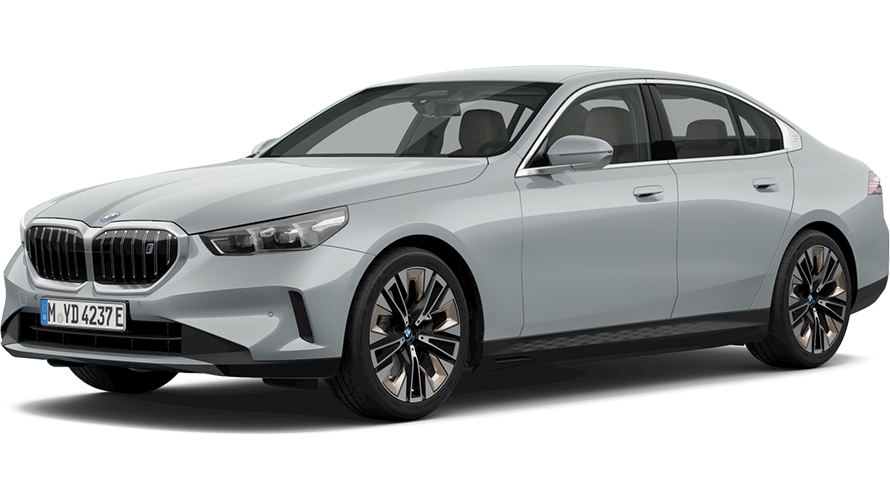Our tool for managing your permission to our use of cookies is temporarily offline. Therefore some functionality is missing.
THE LATEST BMW 5 SERIES.
The BMW 5 series is the epitome of a sporty and comfortable business sedan. The vehicles combine the equipment options of their time with dynamic driving characteristics made possible by perfectly coordinated suspensions and powerful efficient engines. An elegant look guarantees an appropriate appearance for any situation.
Its mission statement: setting new standards. The BMW 5 Series is the embodiment of the modern business sedan. Thanks to its dynamic and simultaneously elegant appearance, it convincingly meets the expectations that are placed today on a vehicle of its class: aesthetic athleticism and driving pleasure with state-of-the-art technology.
Think creatively. Move with the times. Two essential concepts for sustainable concepts. The BMW 530e Plug-in hybrid implements both approaches perfectly and remains way ahead of its time. It relies on electrifying driving pleasure and, thanks to the plug-in hybrid drive, looks forward to a bright future.
Outstanding driving dynamics, sporty design, maximum comfort – the BMW 5 Series Touring is a true master of its class. It is a versatile all-rounder, equipped with cutting-edge technology, maximum functionality and a large portion of sporting flair. Countless digital services and driver assistance system guarantee comfort, safety and maximum productivity. The generously dimensioned interior conveys absolute quality and with up to 1,700 litres of luggage space volume offers ample room for activities of all kinds. A guarantee of driving pleasure that raises leisure and business to a new level.
The BMW 530e Touring Plug-in-Hybrid combines a powerful petrol engine with an electric motor from BMW eDrive technology. The result is an impressive performance with simultaneous lowering of fuel consumption and reduced CO2 emissions.
Whether you are looking for a used or new BMW 5 Series vehicle – here you will find all the information, test reports and offers for financing and leasing the current BMW 5 Series models – and, of course, a dealer for your test drive as well.
BMW 5 SERIES OVERVIEW.
The BMW 5 series continues the concept of the “New Class”: dynamic vehicles in a modern design, equipped with technological innovations, powerful engines and comfort features from the luxury class. For half a century, optical elements such as the double kidney grille or the “Hofmeister kink” on the C pillar have been style-defining and trademark elements of the sporty business sedan. The BMW 5 series is also the first vehicle from BMW that introduces the new nomenclature of the various series. The first figure indicates the series, the other two figures provide information on the engine. All future series use this naming system. In 1975, the BMW 3 series adopted this principle, in 1976 the BMW 6 series and in 1977 the BMW 7 series.
5 CHARACTERISTICS OF THE BMW 5 SERIES.
- 01 Impressive driving dynamics
- 02 Elegant, modern optics
- 03 Comfortable and elegant interior
- 04 Pioneering technologies
- 05 Best link to all services thanks to BMW ConnectedDrive
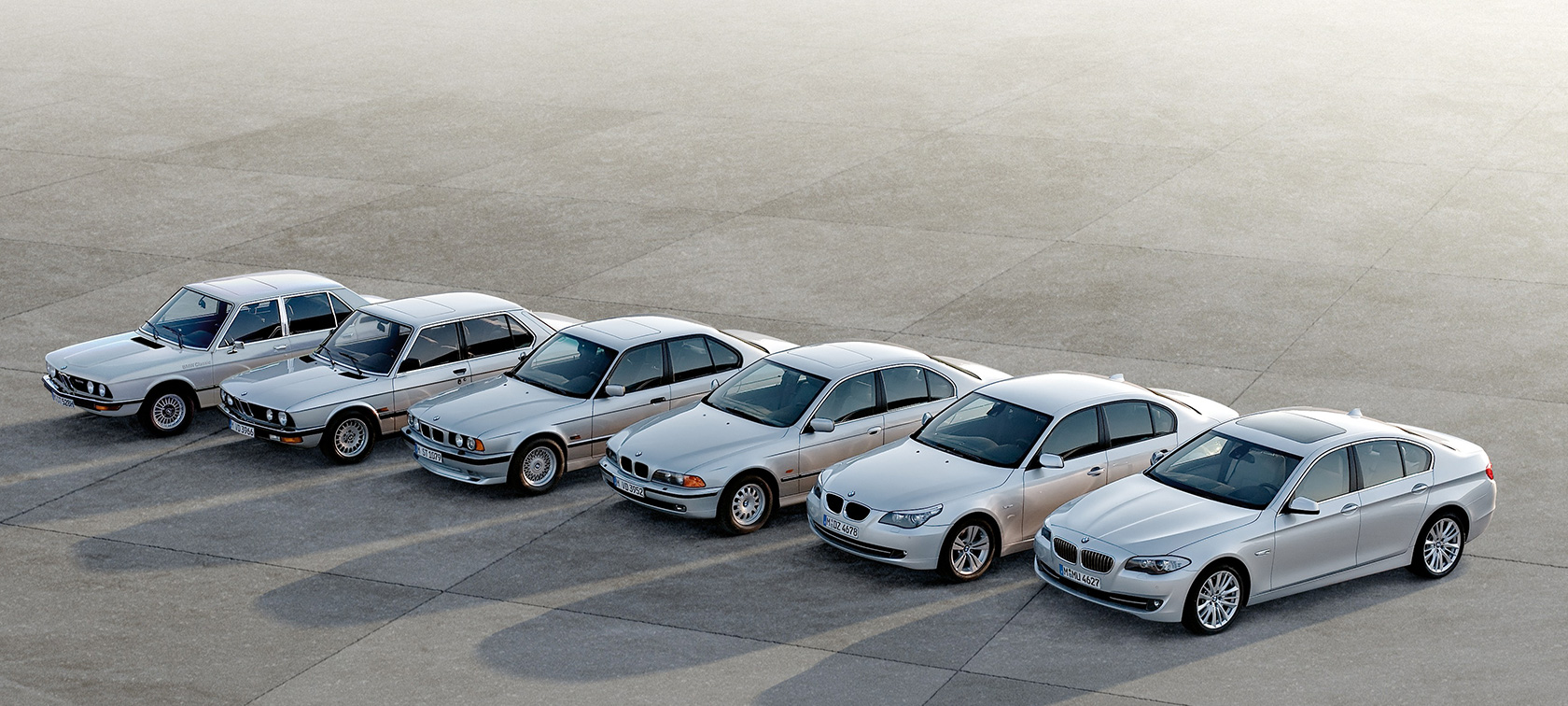
A BRIEF HISTORY OF THE BMW 5 SERIES.
Half a century of the BMW 5 series – the vehicle is a pioneer of its class from the outset and represents the pinnacle of business sedans throughout the world. Find out more about the history of the BMW 5 series.
A BRIEF HISTORY OF THE BMW 5 SERIES.
Half a century of the BMW 5 series – the vehicle is a pioneer of its class from the outset and represents the pinnacle of business sedans throughout the world. Find out more about the history of the BMW 5 series.
THE FIRST GENERATION BMW 5 SERIES.
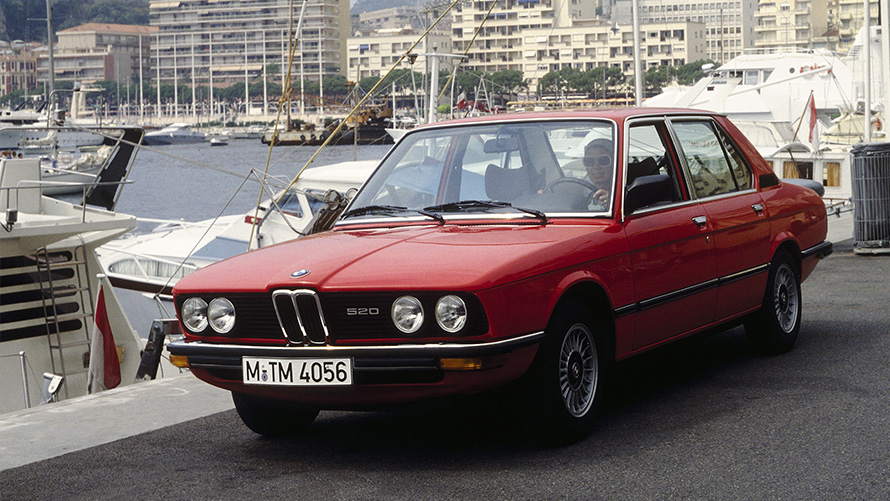
(BMW E12)
In 1972, the first vehicle created by design-legend Paul Bracq for BMW comes onto the market. The BMW 5 series already exhibits all of the features that will distinguish the sedan of the upper midsize class in the future as well: the striking radiator grille with double headlights, the extended silhouette, the rear-wheel drive typical of BMW. Accompanying these features is the suspension, a combination of athleticism, safety and comfort. Inside the cockpit, a more stringent functionality prevails rather than fanciful details. The interior inspires with haptically impressive materials and its comfort features.
The following year sees the emergence of more powerful engines onto the market: the BMW 525 with 107 kW (145 hp), followed by the BMW 528 with a 121 kW (165 hp) engine.
As from the model year 1977, the facelift process carried out for all vehicles leads to the slight raising of the bonnet from the kidney grille to the windscreen, enlargement of the rear lights and the equipping of the 6-cylinder models BMW 525 and 528 with dual carburettors. This brings about an increase in power for the vehicles. With just under 700,000 vehicles built, production ceases with the appearance of the successor BMW 5 series (E28).
Production period: 1972 – 1981
Engines: 1.8 – 3.5 litres (66 – 160 kW, 90 – 218 hp), 4- & 6-cylinder
Length/width/height: 4,620 mm/1,690 mm/1,425 mm
THE SECOND GENERATION BMW 5 SERIES.

(BMW E28)
The successor model of the first BMW 5 series primarily differs in the further technological development of the first generation. The design becomes clearer, more precise and, mainly due to the raising of the rear section, more aerodynamic. The typical front section remains unchanged with the double headlights in the radiator grille. New technical innovations such as ABS, airbag, electronic engine control, exhaust gas catalytic converters or an on-board computer become available for the first time. Almost all engines now have manifold injection.
In 1983, the first BMW 5 series model is equipped with a diesel engine: the BMW 524td produces 85 kW (115 hp) and is the fastest diesel sedan in the world at the time.
In 1985, alongside the BMW M535i, the first BMW M5 becomes available and founds a line of sports sedans to show that exceptional driving performances do not have to be the exclusive domain of exotic sports cars. Produced entirely by hand, the BMW M5 has the same inline 6-cylinder engine with 3.5-litre displacement as the BMW M635Csi and an output of 210 kW (286 hp). At the same time, its understatement produces a dignified appearance.
M variants of the E12 were available from BMW M GmbH in small numbers as long ago as 1974. This development culminates in the BMW M535i. With its large front spoiler and a 6-cylinder engine producing 160 kW (218 hp), it sets top marks in terms of both appearance and sporting performance.
Up until the end of 1987, more than 722,000 vehicles from the BMW 5 series (E28) leave the plant.
Production period: 1981 – 1987
Engines: 1.8 – 3.5 litres (66 – 210 kW, 90 – 218 hp), 4- & 6-cylinder
Length/width/height: 4,620 mm/1,700 mm/1,415 mm
THE THIRD GENERATION BMW 5 SERIES.
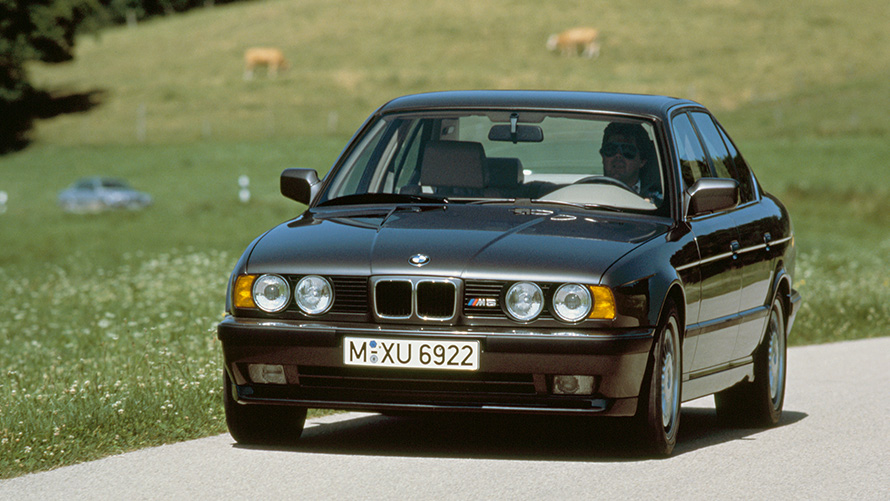
(BMW E34)
The BMW 5 series (E34) presented to the public in January 1988 is significantly larger and broader than its predecessor: the clearly improved aerodynamics with a Cw value of 0.30 ensure that all petrol-engine models of the BMW 5 series are able to travel faster than 200 km/h. Thanks to the long wheelbase and an almost optimum weight distribution of 50:50 on the front and rear axles, the vehicle impresses with its sporty and dynamic driving characteristics – from the BMW 518i powered by 4 cylinders to the BMW M5 with its 232 kW (315 hp), which also becomes available during the launch year.
In 1991, the BMW 5 Series Touring surprised motorists: for the first time there was an estate from BMW in the mid-size executive segment. One special highlight is the rear window that opens independently of the tailgate. In the same year, the doors gain side impact protection for enhanced safety.
In 1992, the first BMW 5 series with all-wheel drive comes onto the market, namely the BMW 525iX. And another first is the equipping of BMW 5 series models with V8-cylinder engines. In the BMW 530i and BMW 540i, these engines stand out due to their especially smooth running characteristics. The BMW M5 retains the inline 6-cylinder power unit. However, its displacement is increased to 3.8 litres, resulting in a growth in output to 250 kW (340 hp). The now more powerful BMW M5 also becomes available in a Touring version.
Production of the Sedan is discontinued in 1995 while sales of BMW 5 Series Touring continue until 1996. A total of 1.3 million units of the vehicle are delivered.
Production period: 1988 – 1996
Engines: 1.8 – 4.0 litres (83 – 250 kW, 113 – 340 hp), 4-, 6- & 8-cylinder
Length/width/height: 4,720 mm/1,751 mm/1,412 – 1,421 mm
THE FOURTH GENERATION BMW 5 SERIES.

(BMW E39)
Despite its greater dimensions, the weight of the bodyshell of the BMW 5 series (E39) remains identical. This is due to the increased use of aluminium, with the suspension largely consisting of this lightweight metal. The torsion resistance also increases significantly. In addition, the BMW 5 series (E39) available in the showrooms as from 1995 has outstanding protected against rust – more than three quarters of the body is hot-dip galvanised. Combined with the many details, the elegant design produces a record-breaking drag coefficient, making it the best in its class. Up to ten airbags can be supplied as a guarantee of safety.
As from 1997, the BMW 5 Series Touring is also available in this range. And in 1998, a new technology makes its debut in the diesel engines: with the first inline 6-cylinder common rail power unit, BMW sets global standards in terms of the performance and efficiency of diesel engines that are to last for years. The modern engines inspire with their performance and smooth running, from the 4-cylinder diesel to the exceptionally strong V8-cylinder power unit with 294 kW (400 hp) in the BMW M5.
The model revision of the BMW 5 series in the year 2000 delivers the driving lights still used today in the form of a ring around the headlights; also introduced are round fog lights instead of the previous angular models. With more than 1.48 million vehicles delivered (including 266,000 Touring models), the BMW 5 Series sets a new sales record up until the end of production in 2004.
Production period: 1995 – 2004
Engines: 2.0 – 5.0 litres (85 – 294 kW, 115 – 400 hp), 4-, 6- & 8-cylinder
Length/width/height: 4,775 – 4,805 mm/1,800 mm/1,435 – 1,445 mm
THE FIFTH GENERATION BMW 5 SERIES.

(BMW E60, E61)
The design of the BMW 5 Series Sedan (E60/60) available from 2003 with its characteristic shapes originates under the leadership of Chris Bangle. The alternating concave and convex planes create a unique interplay of light and shade, both powerful and dynamic. The operating concept is also adopted from the BMW luxury class sedan, allowing the driver to control the diverse systems of the BMW 5 series by means of iDrive. This is optionally available with Head-Up Display, which projects the most important information relevant to the journey directly into the driver’s field of vision on the windscreen.
The new BMW 5 Series Sedan is larger and more spacious than the predecessor model, although not any heavier but actually up to 75 kg lighter depending on the model. One of the factors responsible for this is the weight-reducing aluminium front section, which in the composite design with the remaining steel bodyshell represents a trend-setting step in body construction.
Adaptive cornering and brake lights are optionally available. Also making its debut in the BMW 5 series, alongside the Dynamic Drive roll stabilisation, is Active Cruise Control (ACC). In combination with the sporty suspension, this enables driving dynamics that are unique in this class. The inline 6-cylinder engines impress as diesels with common rail technology and in the petrol version with Bi-VANOS.
From the start of 2005, the now current BMW M5 comes onto the market with an enormous 5-litre V10 engine delivering 373 kW (507 hp). The dynamic sports saloon is available in both Sedan and Touring models, making it one of the fastest estate cars in the world.
In 2007, the appearance of the vehicle is modernised with alterations to the lighting and bumpers as well as an overhauled iDrive system.
Production period: 2003 – 2010
Engines: 2.0 – 5.0 litres (120 – 373 kW, 163 – 507 hp), 4-, 6-, 8- & 10-cylinder
Length/width/height: 4,841 – 4,855 mm/1,846 mm/1,468 – 1,512 mm
BMW 5 SERIES GRAN TURISMO.
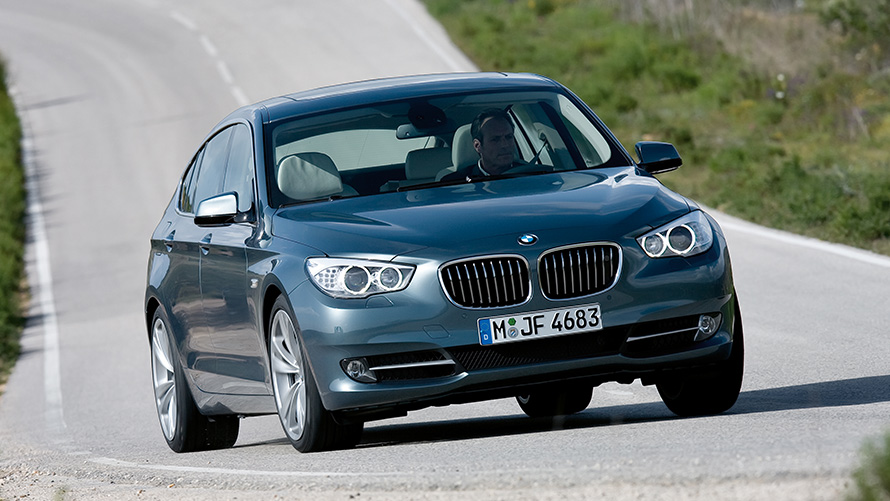
(BMW F07)
In parallel to the BMW 5 series, BMW defines a completely new vehicle segment: the BMW 5 Series Gran Turismo brings together features of a sedan, a flexibly usable Sports Activity Vehicle (SAV) and a classical Gran Turismo. The car combines elegance, a generous and spacious level of comfort and driving dynamics typical of BMW.
The coupé-like roofline and extended side view harmonise with the large BMW kidney grille at the front and the broad appearance of the rear achieved by the L-shaped rear lights and horizontally aligned contours. Due to the engine versions and the standard-feature Dynamic Driving Control and 8-speed automatic transmission, the BMW 5 Series Gran Turismo offers a supreme level of dynamics and efficiency. The suspension impresses with technical innovations such as a double-arm front axle as well as an integral V rear axle and optional Integral Active Steering.
A surprise waits inside in the form of the generously proportioned dimensions and versatile space with elevated seating position and large window panes. Select materials round off the luxurious ambience. Thanks to the BMW iDrive, the driver always maintains a clear overview of the extensive functions of the BMW 5 Series Gran Turismo, such as BMW Connected Drive (optional) with assistance systems such as Lane Departure Warning, BMW Night Vision and the High-beam assistant. In addition, the system offers BMW Online and the BMW Teleservices via Internet connection.
Production period: 2009 – 2017
Engines: 2.0 – 4.4 litres (135 – 330 kW, 184 – 450 hp), 4-, 6- & 8-cylinder
Length/width/height: 4,998 mm/1,901 mm/1,559 mm
THE SIXTH GENERATION BMW 5 SERIES.

(BMW F10, F11)
The most successful generation of the BMW 5 series, with more than two million models sold, comes onto the market in 2010. The sporty and elegant design, the sheer driving pleasure typical of BMW and the large number of innovative technologies secure pole position for the vehicle in the business sedan segment.
The car can be ordered with the intelligent BMW xDrive all-wheel drive system, which distributes the propulsive force to the wheels according to the specific situation. A V8-cylinder engine with BMW Twin Power Turbo producing an output of 300 kW (407 hp) is the most powerful petrol engine. Its counterpart among the diesel power units is an inline 6-cylinder with 220 kW (300 hp). In September 2010, the BMW 5 Series M package becomes available to provide sporty enhancements for the BMW 5 series on both the inside and outside. With the M Sport suspension, the M aerodynamics package and the M light alloy wheels, the vehicle creates an especially powerful impression. Enhancing the interior are sport seats in M design alongside the M leather steering wheel, the M gear knob and M interior trims.
The 2013 facelift involves revamping the design and the inclusion of additional engine options. The series now has xenon headlights and a Bluetooth Hands Free Interface as standard.
A BMW 5 Series Hybrid becomes available from 2016: the BMW 530e iPerformance has a plug-in hybrid engine, enabling it to travel without any local emissions. And this is combined with the characteristics typical of BMW: driving dynamics, comfort and efficiency.
Production period: 2010 – 2017
Engines: 2.0 – 4.4 litres (105 – 423 kW, 143 – 575 hp), 4-, 6- & 8-cylinder
Length/width/height: 4,899 – 5,039 mm/1,860 mm/1,464 – 1,471 mm
THE SEVENTH GENERATION BMW 5 SERIES.

(BMW G30, G31)
From 2017, the BMW 5 series takes the concept of the sporty business sedan to new heights. The design is dominated by the typical BMW proportions, embodied in a long wheelbase, the extended bonnet and flowing roof line. Supporting the clear surfaces and precisely modelled contours is the BMW kidney grille, directly connected with the headlights and emphasising the width of the vehicle.
Modern engines, efficient and available as hybrid models on request, produce driving dynamics that are unrivalled in their class. The optional adaptive suspension and Integral Active Steering provide additional contributions.
Advanced assistance systems are a guarantee of safety in critical traffic situations. The Driving Assistant Professional available on request provides support for situations such as lane keeping or emergency stops.
The 2020 facelift sets clear accents on the exterior such as the redesigned kidney grille, flatter headlights with optional laserlight and new paint finishes. Inside, new comfort seats are available and the assistance systems now offer an Emergency Corridor Assistant and City Braking Activation.
Production period: 2017 – the present day
Engines: 2.0 – 4.4 litres (135 – 390 kW, 184 – 530 hp), 4-, 6- & 8-cylinder
Length/width/height: 4,963 – 4,972 mm / 1,868 mm / 1,467 – 1,498 mm
THE EIGHTH GENERATION BMW 5 SERIES.

(BMW G60)
The new BMW 5 Series reinterprets the sporty design of the model series for the eighth generation. Characteristic design elements such as BMW-typical proportions, a long wheelbase, the elongated bonnet and a flowing roofline are presented in a particularly elegant form. Expressive details such as the illuminated BMW kidney "Iconic Glow", the large panoramic glass roof or the crystalline Interaction Bar give the new BMW 5 Series its own personality.
The wide portfolio of engine options is remarkable: The latest generation of BMW 5 Series is available with a classic petrol or diesel engine, but also as a fully electric BMW i5, plug-in hybrid or particularly powerful M automobile.
Safety and comfort are on board in every engine version. Extensive assistance and connectivity technologies contribute to this. The Driving Assistant Professional, for example, makes long journeys easier, while the BMW Live Cockpit Professional increases the overview of information relevant to driving.
Production period: since 2023
Engines: 2.0 litre, electric motor (120 - 442 kW, 163 - 601 hp), 4-cylinder
Length/width/height: 5,060 mm/1,900 mm/1,505 - 1,515 mm
BMW 5 Series Sedan : Fuel consumption, combined WLTP in l/100 km: 6.4–5.1; CO2 emissions, combined WLTP in g/km: 157–130
BMW i5 Sedan : Energy consumption, combined WLTP in kWh/100 km: 20.6–15.9; Electric range, WLTP in km: 455–582
Fuel consumption and CO2 emissions.
BMW 5 Series Sedan:
Fuel consumption in l/100 km (combined): 6.5–5.1
CO2 emissions in g/km (combined): 157–130
BMW 5 Series Sedan M Automobile:
Fuel consumption in l/100 km (combined): 11.0–10.3
CO2 emissions in g/km (combined): 250–235
BMW 5 Series Sedan plug-in hybrids:
Fuel consumption in l/100 km (combined): 2.2–1.3
CO2 emissions in g/km (combined): 51–30
BMW 5 Series Touring:
Fuel consumption in l/100 km (combined): 8.3–1.5
CO2 emissions in g/km (combined): 194–35
BMW 5 Series Touring plug-in hybrids:
Fuel consumption in l/100 km (combined): 2.2–1.5
CO2 emissions in g/km (combined): 51–35
Official figures for fuel consumption, CO2 emissions, electricity consumption and electric range were determined in accordance with the prescribed measurement procedure and comply with Regulation (EU) 715/2007 as amended. WLTP figures take into account any optional equipment in the case of ranges. For vehicles newly type-approved since 01.01.2021, the official specifications exist only according to WLTP. Further information on the NEDC and WLTP measurement methods can be found at www.bmw.de/wltp
Fuel consumption and CO2 emissions.
BMW 5 Series Sedan:
Fuel consumption in l/100 km (combined): 10.7–1.7
CO2 emissions in g/km (combined): 246–39BMW 5 Series Sedan M Automobile:
Fuel consumption in l/100 km (combined): 10.7
CO2 emissions in g/km (combined): 246BMW 5 Series Sedan plug-in hybrids:
Fuel consumption in l/100 km (combined): 2.3–1.7
CO2 emissions in g/km (combined): 53–39BMW 5 Series Touring:
Fuel consumption in l/100 km (combined): 8.3–1.8
CO2 emissions in g/km (combined): 189–42BMW 5 Series Touring plug-in hybrids:
Fuel consumption in l/100 km (combined): 2.4–1.8
CO2 emissions in g/km (combined): 54–42Official figures for fuel consumption, CO2 emissions, electricity consumption and electric range were determined in accordance with the prescribed measurement procedure and comply with Regulation (EU) 715/2007 as amended. WLTP figures take into account any optional equipment in the case of ranges. For vehicles newly type-approved since 01.01.2021, the official specifications exist only according to WLTP. Further information on the NEDC and WLTP measurement methods can be found at www.bmw.de/wltp




